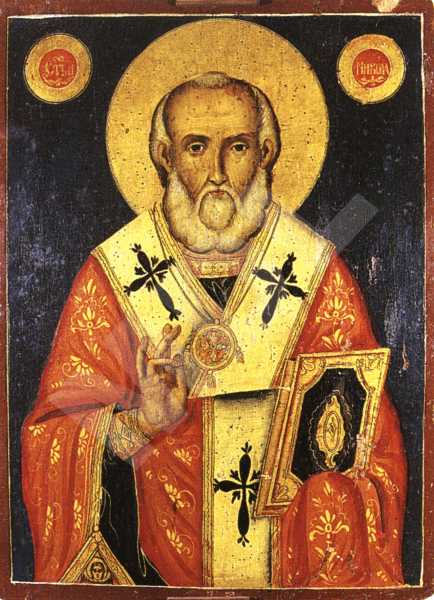St. Nicholas
Type:
Icon
Period:
The first half of the
19 century
Dimiter T. Molerov, born in 1780 in Bansko, son of Toma Vishanov the Moler. One of the best-known painters, a representative of the Bansko school of art, a disciple of his father, influenced by the art of Athos. Author of the murals of the naos in the St Archangels' paraclete in the Rila monastery, the murals in the Church of the Assumption of the Virgin in the Pchelino dependance. In 1840 and 1841 together with his son Simeon Molerov he paints the murals and the sponsors' portraits in St. Nicholas' and St. John of Rila's paracletes in the principal church in the Rila monastery. Among D. Molerov's major achievements in iconography are the following icons: St. Nicholas (1816) from St. Archangel Michael's church in the village of Leshko, Christ All-triumphant with Angels and Cherubim (1833), The Nativity and a Crucifixion from St Elijah the Prophet's church in the village of Usenovo. He has also worked in Belgrade on an invitation by Prince Milosh Obrenovich of Serbia. He died in 1870 in Bansko.
Dimmensions (cm):
59
/ 43
/ 3
Location
Country: Bulgaria
Province: Montana
Town: Berkovitsa
Gallery: Art Gallery
Source
Country: Bulgaria
Other source: Others
Description
A traditional iconographic treatment of the theme. Saint Nicholas is portrayed in waist length against a dark blue background, in archieratical vestments and without a miter. In his left hand he is holding a closed book, and with his right one he is blessing. There are on both sides of the aureole two medallions with the saint's initials. A distinctive feature of the icon is the rich ornamentation with floral motifs on the Saint's vestments.
Iconographical technique: Combined
With velaturas and "probaster" on the vestments. The "wet into wet" method has also been used in the carnations. The varnish cover is applied thinly and evenly. The gilding on the aureole, on the two medallions and on the book is with gold-leaf.
Base material: Wood
The icon's base is made of two softwood panels, joined by means of two inserted beams. The ground coat is of plaster, laid in a thin and even layer.
State, restoration traces and comments
There are numerous damages along the icon's brown frame and in other areas as well. There are traces of retouchings on the face and around the saint's blessing hand, but in other places, like, for example, around the book, the damages have not been removed.


